



When you have successfully completed this section, you will have mastered:
Connectors
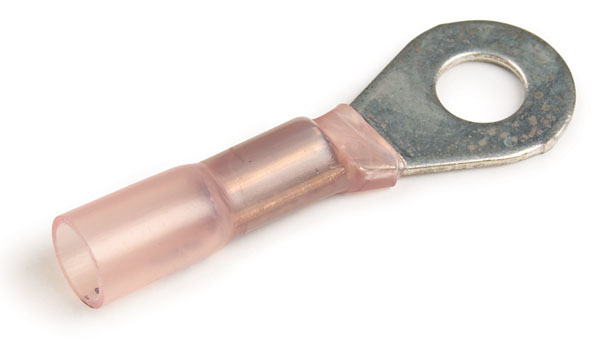
Ring Terminal
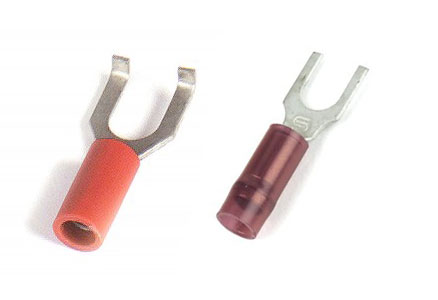
Spade Connectors
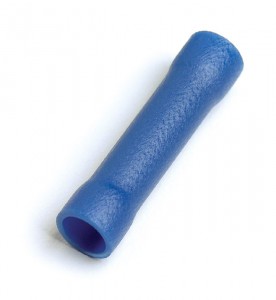
Butt Connector
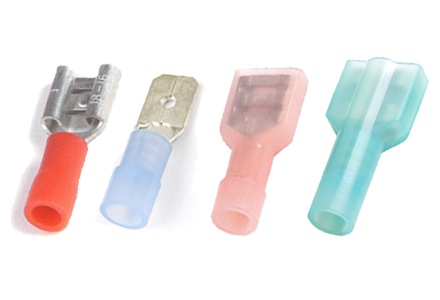
Quick Disconnects
Although Grote's UBS system provides the most effective connections, there are times when wiring requires a more traditional approach. In those situations, it's important to understand the basics of using wire, connectors and related components.
Wire end connectors are used to connect two or more wires or attach a wire to a device. They are used because it takes much less time to make a connection than twisting wires or soldering them. Using wire-end connectors, wires are connected securely and permanently.
Ring terminals get their name from the distinctive shape of the connector. They are the most common type of connector. They are very efficient at conducting electrical current because of the amount of conductor in contact with the stud. Ring terminals are one of the best choices for security because the ring cannot be disconnected unless it is completely disengaged from the stud.
Spade terminals are popular because they can be assembled and dismounted quickly. Attaching and removing requires only that the stud be loosened.
Hook terminals get their name from their distinctive shape. They are a blend of the ring terminal and the spade terminal. The slot on the side allows them to slip under the loosened stud, while the hook shape adds an extra measure of holding power over the spade connector.
Butt connectors are used to splice two wires together end to end. It is simple to use. Just push the ends of the two wires into the butt connector and crimp it tightly.
Three-way connectors and four-way connectors function similarly to the butt connector. However, as the names implies, they join up to four wires together.
Quick Disconnects are based upon a design featuring a quick disconnect male piece that fits into the corresponding slot on the opposite half of the splice. The design allows the splice to be connected and unconnected almost indefinitely. As with certain others, the quick disconnect terminals are available with heat shrink tubing.
Bullet connectors get their name from the shape of the male half of the connector set. The other half has a socket, which accepts the male half. Similar to other quick disconnect connectors, bullet connectors allow the splice to be disconnected and reconnected.
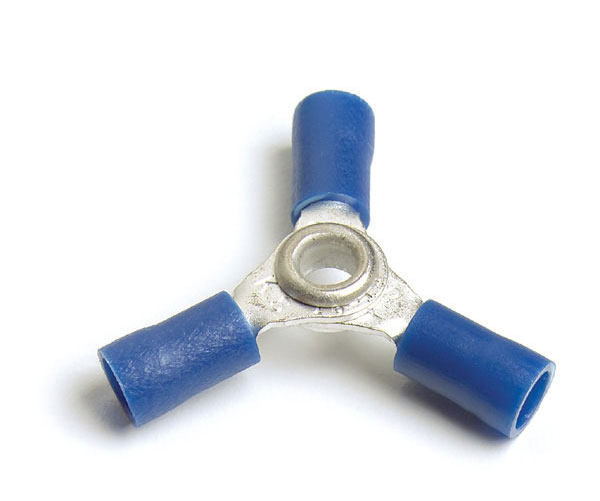
Three Way Connector
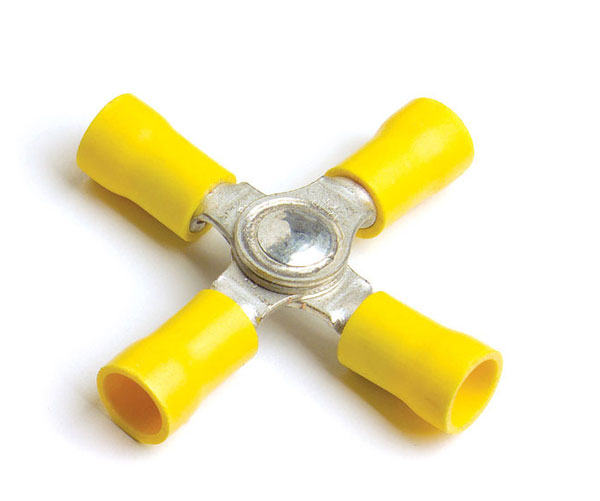
Four Way Connector

Bullet Connectors
Once a connection has been crimped, shrink tubing should be used to cover the end of the connector and the end of the wire. This protects the wire and connector from moisture, corrosion and contaminants. Several of the basic connectors come complete with shrink tubing replacing the PVC insulation.
Power Cords
Connecting a trailer's electrical system and the tractor electrical system requires a power cord that is rugged and safe to use. The Grote accessories line includes several alternatives. All share a number of features that give them the ability meet demanding service environments. For example, they are totally sealed to prevent corrosion. They utilize sonicwelded terminals for minimal voltage drop along with a shockproof, molded plug body to protect users from injury. Special stainless steel springs assure tight connections and brass plated terminals provide enhanced current carrying capacity.
It's important to choose the right cord for the job. A case in point is trailers that use ABS. By law, ABS power cords must use 10 gauge wire in the red, white and blue wires. That's heavier than a standard power cord.
There are times when damage or wear requires replacement of components of trailer connection systems. There is a whole line of nose boxes, receptacles, some with circuit breakers and others with replaceable solid brass pins to meet specialized needs.
Switches
Switches represent another sort of connection. They make controlling the flow of electrical current easier and, of course, much more convenient. Imagine having to connect wires whenever the situation calls for light and disconnect wires to shut them off.
Choosing a switch requires some basic information. Check the installation guide or service manual for any information that might help you to select the correct replacement switch.
Switches come in a variety of designs. They range from push-pull types to toggles. Ignition switches are usually complete with keys and many applications require the streamlined look of a rocker switch.
Push-pull switches are popular for use on vehicles. They are easy to operate and come in various types from standard pull-on, push-off to multi-position on-off-on or off-high-low. Push-pull switches are typically available in medium-duty, heavy-duty and extra heavy-duty.
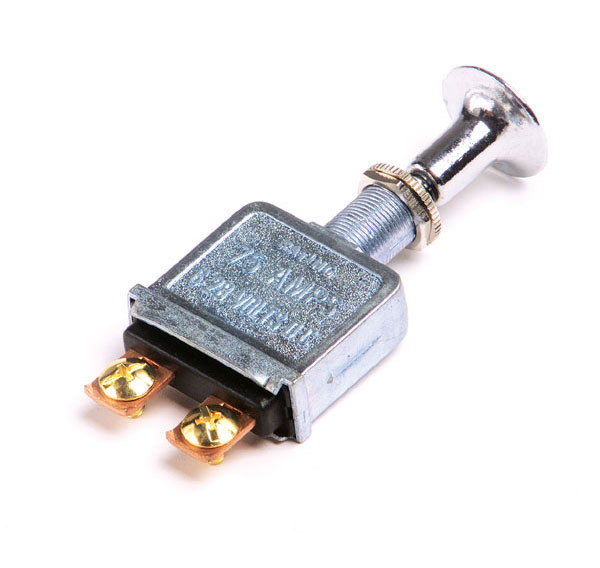
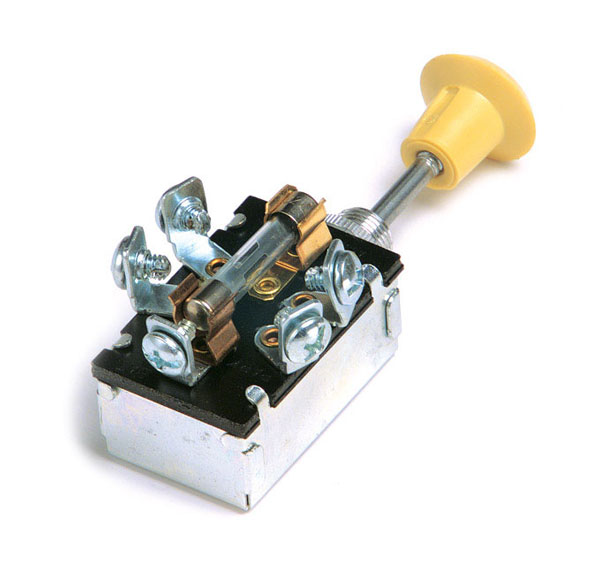
Push-Pull Switches
Toggle switches can be operated with just one finger. They too come in various types. The simplest is the two-position, on-off. Variation on that are the on-off-on or the on-on. Like push-pull switches, toggles come in medium-duty, heavy-duty and extra heavy-duty.
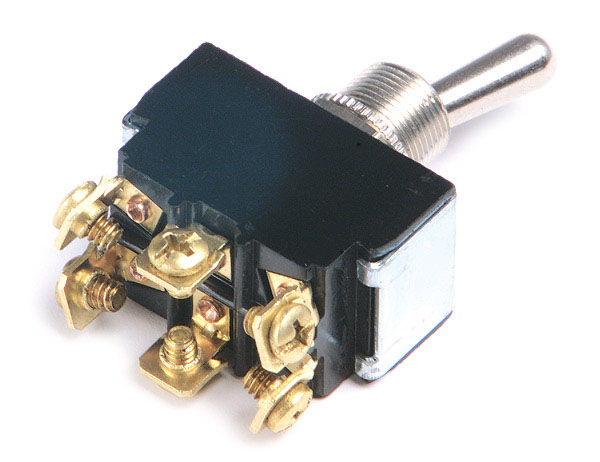
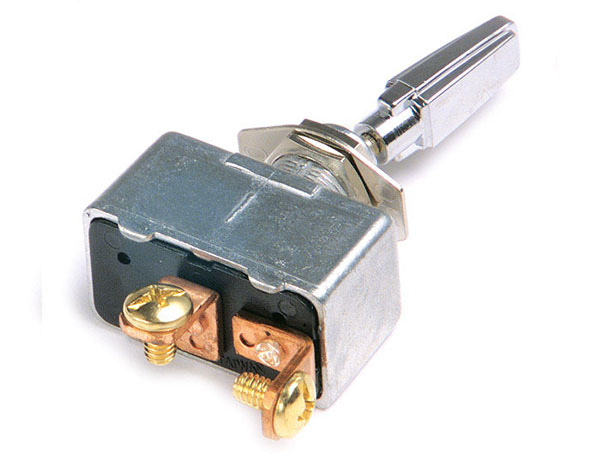
Toggle Switches
Proper Connections
Making certain that connections are safe and secure will go a long way toward avoiding problems in the future. Creating good connections requires good techniques and practices along with the best quality terminals and ancillary products. Improper technique or poor quality terminations can result in a number of problems including failure of the connections. Short of total failure, one of the most serious problems resulting from bad connections is excessive resistance in the system.

First, strip the wire to expose the correct amount of wire for the termination you’ve selected.
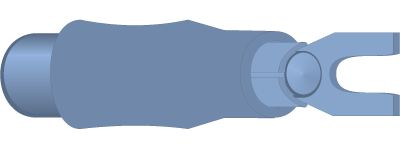
Correctly applied termination.
Resistance generates heat and reduces the flow of current through the connection. A case in point is a bulb that glows softly and unsteadily at times, instead of shining brightly and steadily. Depending upon the cause, the connection may fail completely and the light along with it.
Creating a good connection can be quick and sure. Start by stripping the correct amount of insulation from the wire. The bare conductor should be as long as necessary to match the length required by the terminal. If the stripped area is too long, the exposed wire may touch a metal part of the vehicle and cause a grounded circuit. Too short and there may not be enough contact area between the conductor and the terminal, possibly causing increased resistance.
Corrosion and contamination can seriously effect a terminal connection by forming a barrier between the conductor and terminal. Always clean the conductor until the exposed surface is bright and shiny before making the connection. Some even advise “tinning” the wire, putting a light coating of solder on it to create a shiny, clean surface for the connection.
Crimping is the most widely used method of securing terminal connections. To crimp a connection, simply squeeze the terminal body to hold the wire in place. It's important to make the crimp tight enough to hold the wire securely.
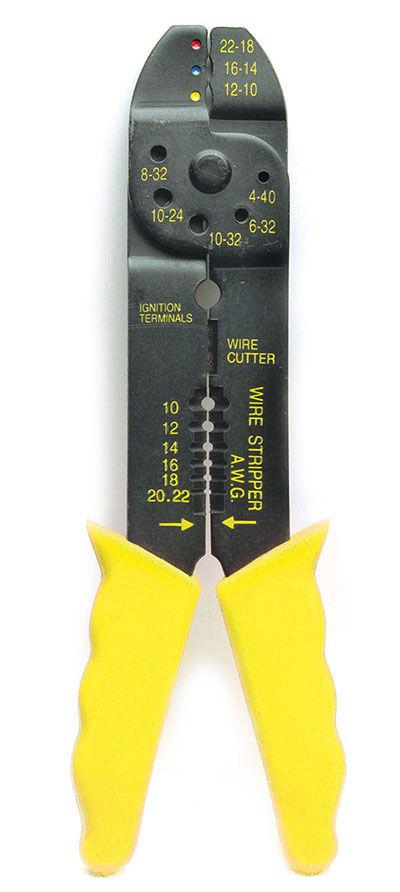
Crimping Tool
Loose crimps can create excess resistance in the connection since the wire doesn't make a good contact. Improper crimping can lead to excess heat and reduced current.
In some cases, a loose crimp can pull apart completely and create an open circuit with no current low at all. But not all problems are caused by loose crimps.
An overly tight crimp could break the strands of wire making the conductor smaller. That can cause excess resistance as the current flows through the smaller number of strands in the conductor.
Protecting the connection is a key step in avoiding future problems. In the past, that protection came from wrapping the connection with tape. It was a time-consuming process, often with less than satisfactory results as the tape was seriously affected by moisture and extremes in temperature.
Heat Shrink Tubing
Heat shrink tubing solves all of those problems and provides a method of sealing out moisture, corrosion and other contaminants. It also provides a high level of insulation for the splice.
Shrink tubing is simple to use. Just position the tubing over the joint and add heat from a torch or heat gun. The tubing shrinks tightly around the connection providing a secure barrier. When the tubing has cooled, check that it fits snuggly. When securely in place, the tubing acts as a strain relief for the connection. It also helps immobilize the connection to prevent fatigue and eventual failure.
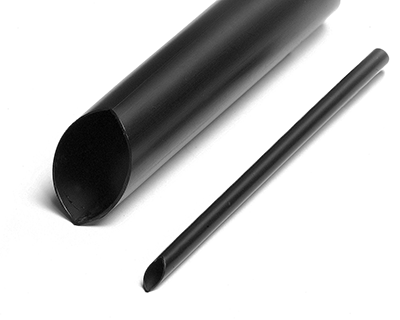
Heat Shrink Tubing
Single wall heat shrink tubing is the most basic type. Its function is simply to shrink around the connection. Single wall shrinks in a ratio of two to one. In other words the finished size is half of the original size.
Dual wall has an outer wall that shrinks similar to the single wall tubing. However, this product has an inner wall of sealant that flows around the connection to fill any irregularities and openings and add strength to the joint. When complete, there should be a bit of clear sealant around each end of the tube. The shrink ratio of this product is three to one.
Dual wall hot-melt adhesive is a third type heat shrink tubing. It also has a two-layer construction. In this case though, the inner layer is made up of a hot-melt adhesive. When heated, the outer wall shrinks and the inner wall melts forming a superior barrier against moisture as well as corrosion and other contaminants. There should be evidence of clear adhesive at the each end of the tube if the inner wall has melted correctly. This product is designed especially for insulating and protecting against the underhood environment. The shrink ratio is four to one.
Dielectric Coating
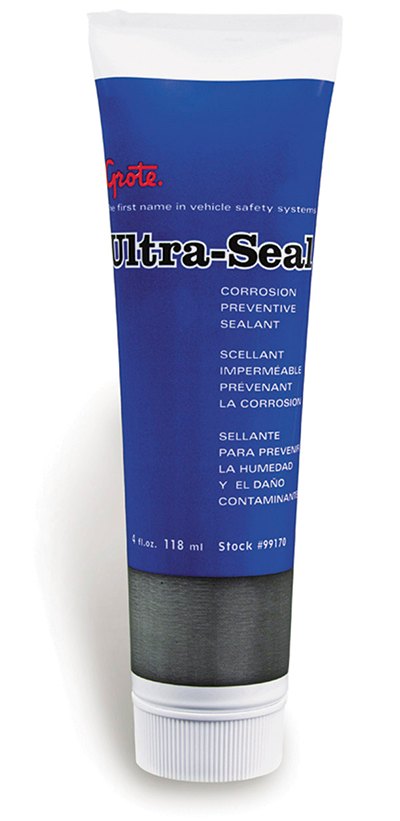
A very important component of safe and secure connections is the use of a dielectric (non-conductive) coating. It functions primarily as a barrier to moisture and other contaminants, preventing them from reaching the connection. Using the dielectric coating helps prevent the development of corrosion, a major cause of failure in splices and connections.
When using a dielectric coating, apply it to all of the components of the splice or connection. Then finish the job by crimping or otherwise securing the connection. Use only enough to protect the actual joint. Using too much does not provide additional protection.
Wire and connections, by their very nature, are vulnerable to damage. They are subject to abrasion, cuts, breaks and disconnects. That's even truer for vehicle applications. Protecting the wiring is an important factor in the safe operation of any vehicle.
Unorganized wiring is harder to protect than well-organized, orderly systems. Situations where wires are run everywhere are an open invitation to damage and failures.
Well-organized wiring is easier to trace. Repairs are easier because there's less searching and testing to find the right wires.
Organizing the wiring can be done using a variety of methods. But there are some approaches to avoid and materials that are not designed for the job. As an example, avoid using discarded lengths of wire to group vehicle wires and secure bundles. That's true even if the used wire still has insulation on it.
Avoid using any kind of metal brackets with sharp and unprotected edges to drape wires over. String is inconvenient to use and a fire hazard, as is cloth. Electrical tape is often found wrapped around bundles of wire. But tape is adversely affected by heat and cold causing failure and leaves a sticky residue.
There are many wiring accessories that are specially designed to organize and secure vehicle wiring.
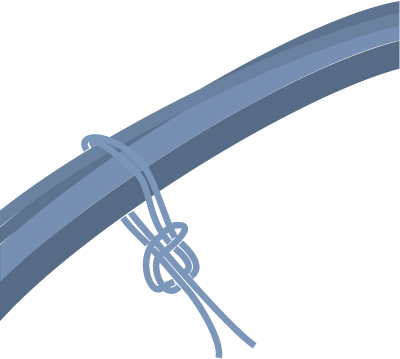
Avoid using string to wrap wire bundles.
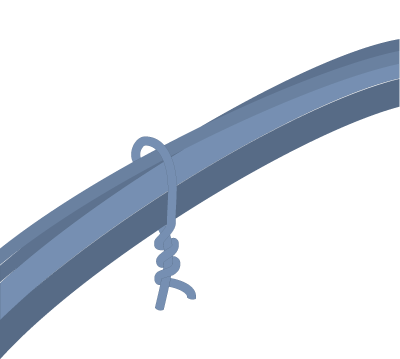
Avoid using scrap to wrap wire bundles.
Cable Ties
Cable ties are made of flexible nylon, they use a specially designed ratchet patterned strap that fits into a slot on the head of the tie, holding bundles of wires snugly and securely.
They are easily the best alternative for securing groups of wires either to themselves or to structural members. Grote ties are made of a material that absorbs and releases moisture depending upon the moisture in the environment. That helps the ties remain snug over a longer life. With wires snuggly gathered, they are less prone to vibration and abrasion. All black ties are ultraviolet (UV) light resistant for extended service life.
Ties come in several types and sizes.
Miniature ties are perfect for smaller bundles. And they are also used in applications where space is limited making it difficult to apply full size ties.

Standard Cable Ties
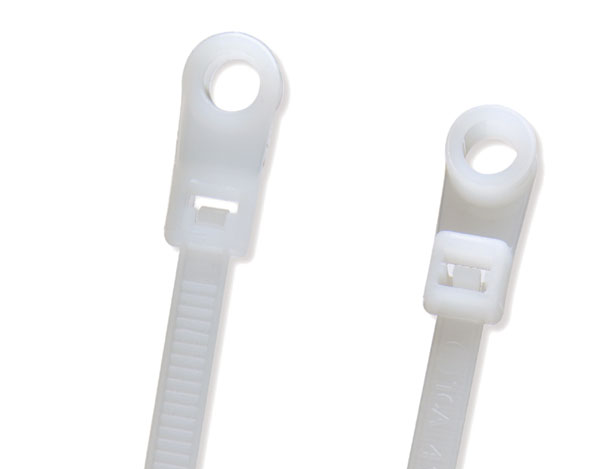
Mounting Cable Ties
Standard ties are the most popular and offer all of the Grote advantages including the black, UV resistant style.
Heavy-duty ties offer the advantages of the standard type along with heavier construction. HD ties are the choice where bundling heavier wire and cables calls for a stronger solution.
Mounting ties come with a pre-drilled hole at the slot end. That allows the tie to be secured with a screw, holding the bundle of wires securely in place on a structural member and away from harm.
Color ties enjoy all of the general utility of the others and come in a variety of colors. This variation makes color-coding simple and easy.
Wire Tubing and Wraps
Other unitizing products include a variety of tube –like products designed to surround bundles of wires.
Spiral wrap is a spiral cut tube made so that wires can be routed in and out of the tube to separate destinations without disturbing the
rest of the bundle. It has a built-in memory that allows it to be stretched to accommodate a wire and return to its original shape and size.
Split flex convoluted tubing is tough and easy to use. It's a corrugated wall tube with a slit running the total length. To use, just spread the tub open and place wires inside. Then just allow the tube to take its original form, again.
Fibre loom is a non-metallic, fibrous material that offers abrasion resistance and protection against moisture. It provides a cost-effective solution to the control and protection of vehicle wiring.
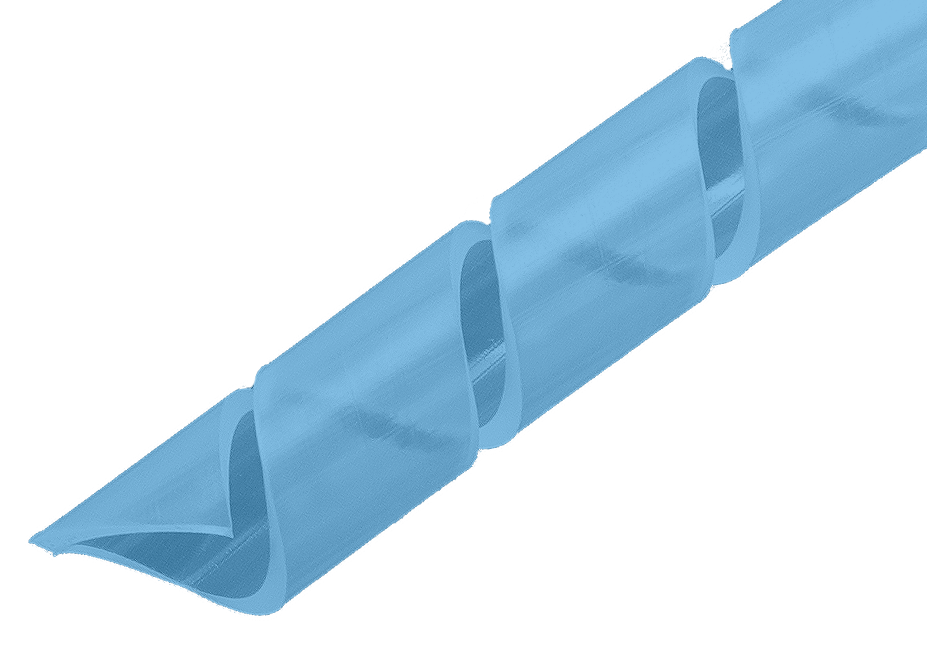
Spiral Wrap

Spiral Flex

Fibre-Loom
Clamps
Another category of wire routing devices is clamps. Most share the same “C” shape. Clamps are particularly valuable for holding bundles of wire when routing them around obstacles.
Nylon clamps are very tough and durable. They are non-conducting and are highly corrosion resistant and easy to install.
Neoprene rubber insulated clamps are dipped to create a cushion layer over a rugged metal base. The covering is non-conducting so it provides a layer of insulation. The neoprene also provides a vibration dampening effect.
Neoprene cushion clamps come with a thick layer of rubber cushion attached to a sturdy metal clamp. That arrangement provides a superior level of vibration dampening and excellent protection for the wire bundle.

Nylon Clamps
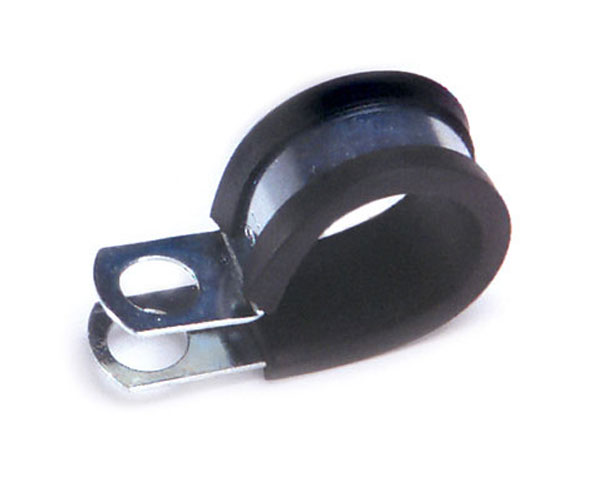
Neoprene Rubber Cushion Clamps
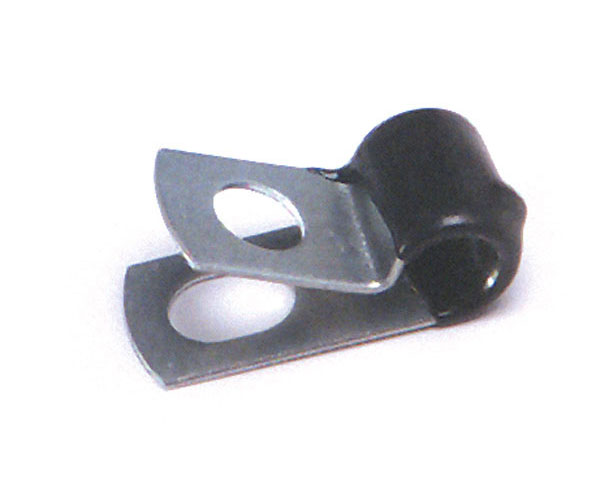
Neoprene Rubber Insulated Clamps
Use the self assessment below to gauge your understanding of this section. Place your answer in the box and then check your answer by clicking on the "show answer" link.
Or, you can skip the assessment.
Instructions:
Read the question.
Place your answer in the box.
Example:
True or False:
You should read the questions and then type your answer into the box.
show answer
True!
Begin:
1. True or False: Because of their design, ring terminals make one of the most secure con- nections.
show answer
True
2. True or False: Ring terminals are the second most popular of all types
show answer
False
3. True or False: Spade terminals can’t be disconnected unless they are completely disengaged from the stud.
show answer
False
4. Hook terminals:
show answer
c) Have more holding power than a spade connector
5. True or False: Three-way connectors are used to connect wires in a “T” shape.
show answer
True
6. True or False: Blade connectors are often used to connect and disconnect splices.
show answer
True
7. True or False: Bullet connectors are used in situations where the splice is to be connected and disconnected repeatedly.
show answer
True
8. Grote power cords
show answer
>d) All of the above
9. In choosing a switch, it’s necessary to consider:
show answer
d) All of the above
10. True or False: Toggle switches are available in light-duty models only.
show answer
False
11. True or False: Short of total failure, the most serious problem caused by a poor connection is excessive resistance.
show answer
True
12. Tru or False: Improper wire stripping can cause increased resistance.
show answer
True
13. True or False: “Tinning” refers to soldering wires together.
show answer
False
14. True or False: Loose crimps can cause an open circuit.
show answer
True
15. True or False: Crimping is the most often used method of securing terminal connections.
show answer
True
16. With single-wall heat shrink tubing, the ratio of original to finished size is as much as:
show answer
b) 2 to 1
17. True or False: Dual-wall shrink tubing refers to a product designed to protect wiring from the underhood environment.
show answer
True
18. Dielectric coating refers to:
show answer
a) An anti-corrosion coating
19. True or False: When used with a layer of tape, leftover wire can be used to bundle wires.
show answer
False
20. Well organized wires are generally
show answer
d) all of the above
21. True or False: Cable ties are easily the best alternative for securing wires to themselves or a structural member.
show answer
True
22. True or False: Mounting ties are primarily used to secure lighting devices to trailer sides.
show answer
False
23. True or False: A spiral wrap allows routing wires in and out without disturbing others in the bundle.
show answer
True
24. True or False: Clamps come in a variety of shapes such as a “C” configuration.
show answer
b) True